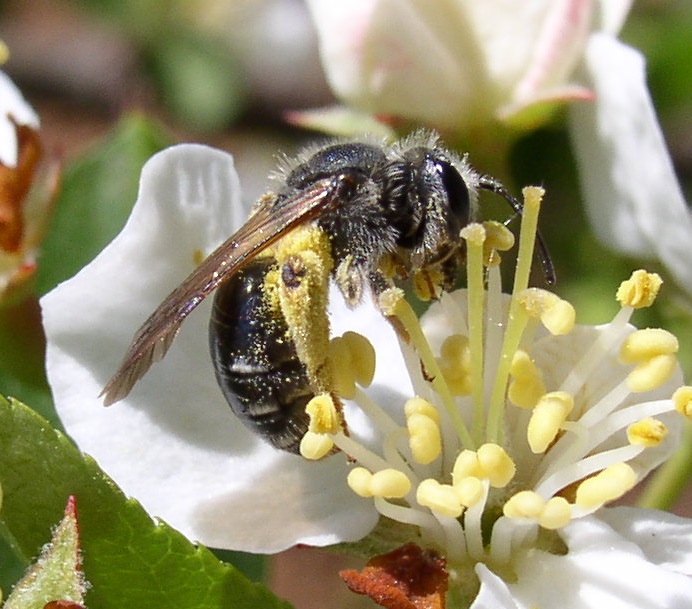Andrenidae on:
[Wikipedia]
[Google]
[Amazon]
 The Andrenidae (commonly known as mining bees) are a large, nearly
The Andrenidae (commonly known as mining bees) are a large, nearly
''Andrena'' Image Gallery from Atlas HymenopteraNorth American Andrenidae
Identification guides to eastern North American Andrenidae
{{Taxonbar, from=Q853287 Bee families
 The Andrenidae (commonly known as mining bees) are a large, nearly
The Andrenidae (commonly known as mining bees) are a large, nearly cosmopolitan
Cosmopolitan may refer to:
Food and drink
* Cosmopolitan (cocktail), also known as a "Cosmo"
History
* Rootless cosmopolitan, a Soviet derogatory epithet during Joseph Stalin's anti-Semitic campaign of 1949–1953
Hotels and resorts
* Cosmopoli ...
family of solitary, ground-nesting bee
Bees are winged insects closely related to wasps and ants, known for their roles in pollination and, in the case of the best-known bee species, the western honey bee, for producing honey. Bees are a monophyletic lineage within the superfami ...
s. Most of the family's diversity is located in temperate or arid areas (warm temperate xeric). It includes some enormous genera (e.g., '' Andrena'' with over 1300 species, and '' Perdita'' with over 700). One of the subfamilies, Oxaeinae, is so different in appearance that they were typically accorded family status, but careful phylogenetic
In biology, phylogenetics (; from Greek φυλή/ φῦλον [] "tribe, clan, race", and wikt:γενετικός, γενετικός [] "origin, source, birth") is the study of the evolutionary history and relationships among or within groups ...
analysis reveals them to be an offshoot within the Andrenidae, very close to the Andreninae. C. D. Michener (2007) ''The Bees of the World'', 2nd Edition, Johns Hopkins University Press.
Description
The Andrenidae are typically small to moderate-sized bees, which often have scopae on the basal segments of the leg in addition to thetibia
The tibia (; ), also known as the shinbone or shankbone, is the larger, stronger, and anterior (frontal) of the two bones in the leg below the knee in vertebrates (the other being the fibula, behind and to the outside of the tibia); it conn ...
, and are commonly oligolectic (especially within the subfamily Panurginae). They can be separated from other bee families by the presence of two subantennal sutures on the face, a primitive trait shared with the sphecoid wasps. Many groups also have depressions or grooves called "foveae" on the head near the upper margin of the eyes, another feature seen in sphecoids
The Spheciformes is a paraphyletic assemblage of insect families which collectively comprise the "sphecoid wasps". Larvae are carnivorous.
These are all the members of the superfamily Apoidea, which are not bees and which in older classificatio ...
, and also shared by some Colletidae. Andrenids are among the few bee families that have no cleptoparasite
Kleptoparasitism (etymologically, parasitism by theft) is a form of feeding in which one animal deliberately takes food from another. The strategy is evolutionarily stable when stealing is less costly than direct feeding, which can mean when foo ...
s. The family contains a very large number of taxa, especially among the Panurginae, whose sting
Sting may refer to:
* Stinger or sting, a structure of an animal to inject venom, or the injury produced by a stinger
* Irritating hairs or prickles of a stinging plant, or the plant itself
Fictional characters and entities
* Sting (Middle-earth ...
apparatus is so reduced that they are effectively unable to sting.
The subfamily Oxaeinae is rather different in appearance from the other subfamilies, being large, fast-flying bees with large eyes, resembling some of the larger Colletidae.
The Andrenidae are known from the Eocene
The Eocene ( ) Epoch is a geological epoch that lasted from about 56 to 33.9 million years ago (mya). It is the second epoch of the Paleogene Period in the modern Cenozoic Era. The name ''Eocene'' comes from the Ancient Greek (''ēṓs'', ...
-Oligocene
The Oligocene ( ) is a geologic epoch of the Paleogene Period and extends from about 33.9 million to 23 million years before the present ( to ). As with other older geologic periods, the rock beds that define the epoch are well identified but t ...
boundary, around 34 Mya, of the Florissant shale.
"Nocturnal" species
The Andrenidae are one of the four bee families that contain somecrepuscular
In zoology, a crepuscular animal is one that is active primarily during the twilight period, being matutinal, vespertine, or both. This is distinguished from diurnal and nocturnal behavior, where an animal is active during the hours of dayli ...
species; these species are active only at dusk or in the early evening, and therefore technically considered " vespertine". In the Andrenidae, such species occur primarily in the subfamily Panurginae. These bees, as is typical in such cases, have greatly enlarged ocelli
A simple eye (sometimes called a pigment pit) refers to a form of eye or an optical arrangement composed of a single lens and without an elaborate retina such as occurs in most vertebrates. In this sense "simple eye" is distinct from a multi-l ...
, though one crepuscular subgenus of '' Andrena'' has normal ocelli. The other families with some crepuscular species are Halictidae
Halictidae is the second-largest family of bees (clade Anthophila) with nearly 4,500 species. Halictid species are an extremely diverse group that can vary greatly in appearance. These bees occur all over the world and are found on every continen ...
, Colletidae, and Apidae
Apidae is the largest family within the superfamily Apoidea, containing at least 5700 species of bees. The family includes some of the most commonly seen bees, including bumblebees and honey bees, but also includes stingless bees (also used for ...
.
References
External links
''Andrena'' Image Gallery from Atlas Hymenoptera
Identification guides to eastern North American Andrenidae
{{Taxonbar, from=Q853287 Bee families